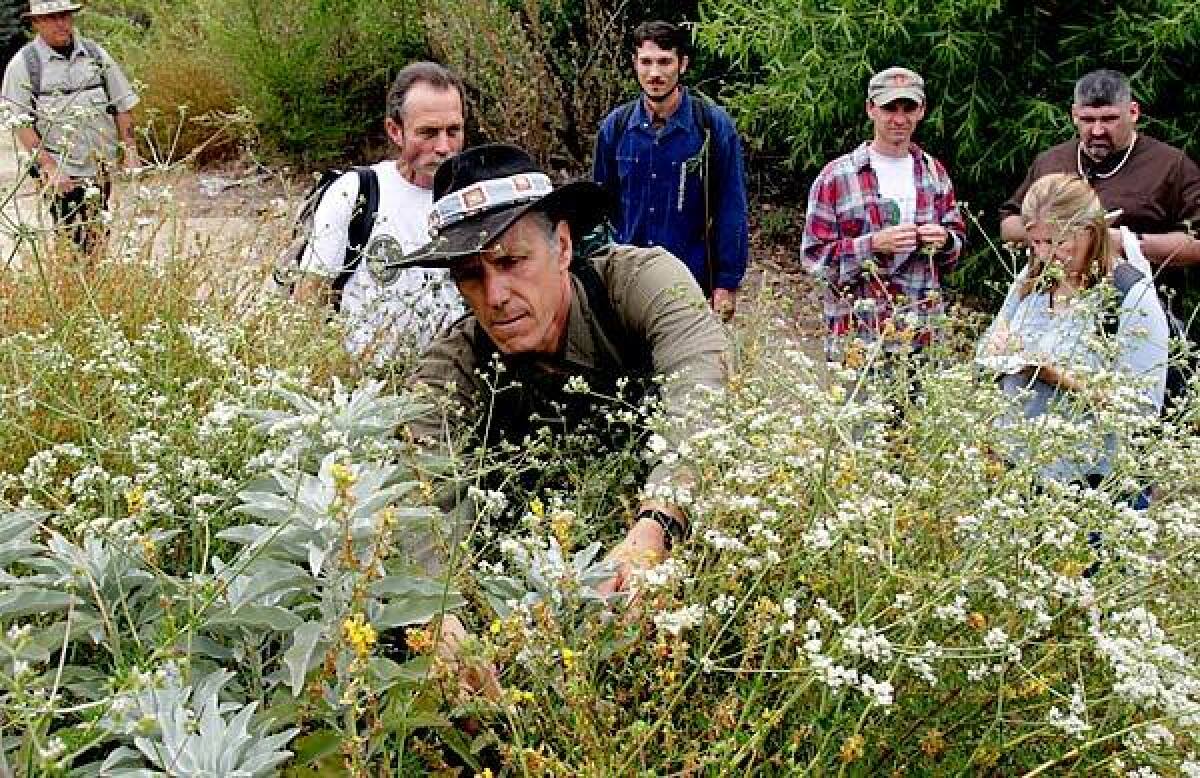For the self-reliant, the wild is a free buffet

On an overcast Saturday morning, Christopher Nyerges — the head of Eagle Rock’s School of Self-Reliance — gingerly skirts a feral clump of bright green weeds.
“Always watch where you’re stepping ‘cause you might be stepping on our lunch,” he says to the 17 students following him. Resembling troops in an outdoorsy New Age army, the group wanders through Pasadena’s Hahamongna Watershed Park, scouring the dirt hills, shallow valleys and parched riverbeds of the land for edible plants as part of a wild food outing that Nyerges regularly teaches.
Nyerges knows what most urbanites don’t: that food is in the eye of the beholder. He scans the foliage around him with sharp, knowing eyes, recognizing the shape and veins of a leaf; the texture of bark on a tree; the color of a berry; the gentle slope of a stem crowned with flowers. It’s all salad to him.
Those pesky “weeds” that you routinely pull in your backyard might be lambsquarters, greens rich in vitamins A and C that can be eaten just like spinach and are good raw or sautéed. Or maybe they’re amaranth, which is also called pigweed. (In Jamaica it is steamed and served with butter and cheese.)
The list of possibilities is lengthy and nutritious. That is, if your palate and stomach enjoy life on the wild side. These plants take getting used to, and if you’re not careful you could end up with a belly ache, or worse.
“Wild foods are full potency in terms of vitamins and minerals,” says Nyerges, who is the editor of Wilderness Way magazine and has penned a wild food cookbook along with nine other self-reliance titles. “I’ve had people get sick eating some of them, but not because they’re poisonous. We generally eat weak food, and when you eat something that’s real, your body might react.” (Try telling that to your general practitioner.)
Clad in faded green army pants, a long-sleeved green button-up shirt and a black cowboy hat banded with a patterned kerchief Nyerges, 55, is motion incarnate. As the group walks along a path covered with a blanket of decaying leaves he spots chickweed, which is mild and tender and makes a great salad green. Dropping suddenly to his knees he plucks a leaf and holds it up for all to see.
“At Whole Foods this costs $15 a pound dried,” he says of the chickweed. “Then there’s a lookalike that has a white milky sap.” He peers about him for a moment, grabs another leaf that looks identical to the chickweed and crushes it between his fingers, revealing a sticky white substance.
“So that’s not edible?” a woman asks. Her long gray hair is pulled back in a ponytail and she wears Teva sandals. Nyerges looks at her with a long, serious face.
“It’s edible, but you’ll vomit,” he says. Everybody chuckles, and Nyerges smiles.
Still, the point he’s making with the joke is deadly serious: You should only eat what you know. If you don’t know it, don’t touch it.
Down a grassy hill and past an elegant row of acacia trees, the mud from a recent rainfall cracks in large thirsty gaps and Nyerges stops short. “Look at this,” he says, pointing at a grouping of flowered plants with wide flat leaves and tiny pepper-shaped growths.
A woman plucks one of the growths and nibbles on it. “It tastes like a radish,” she says thoughtfully.
“It tastes like a radish because it is a radish,” Nyerges says. “A wild radish.”
Nyerges’ eyes narrow, and he swiftly rips a plant from the ground beside a radish plant. It has intricate patterned leaves resembling parsley, only not as thickly bunched.
“Here’s one you should all be aware of,” he says. “That’s poison hemlock. It’s enough to kill you.”
Unnerved, the group peers suspiciously at the contents of their salad bags. Maybe wild food wasn’t as fun as they thought. But, then again, a number of people in attendance, including two men who say they are part of a 9/11 truth group, are not there for fun.
Nyerges, who has been teaching for more than 30 years, says that it isn’t uncommon for hard-core survivalists to take his class, as well as people with end-of-the-world-related fears. “There have been individuals who have been seriously upset about things over the years. During Y2K they were petrified; now I get a lot of that with the 2012 baloney,” he says, referring to what some believe is the Mayan calendar’s end date.
“I tell people that society is not going to change, only the individual can change and that’s the source of calm that comes from true self-reliance,” he continues. “I’m convinced I will never go hungry, I’ll never be homeless, I’ll never be broke.
“More and more I’m dealing with average people who are worried about the nutritional content of their food and what to do if there is a supermarket strike or an earthquake,” Nyerges adds.
Soon the group passes through a field of slender mustard plants. They wave knee-high in the breeze, their dainty yellow flowers shining in the just-emerging sunlight. “Taste the flowers,” Nyerges urges. They are full of heat and spice. “You can eat the leaves too,” he adds as a man holding a book by Nyerges titled “Guide to Wild Foods and Useful Plants” scribbles furiously in its margins.
As the walk plunges deeper into the park, the landscape changes, not in the way it looks, but in the way you look at it. Familiar greenery remains on all sides — however, it is impossible to see it in the same way. It is now filled with hidden secrets to be revealed with each passing step.
Those thick reddish-brown stalks covered in shiny seeds are curly dock. The seeds can be crushed into a powder and mixed with equal parts wheat flour to make hearty pancakes. Those round white flowers are buckwheat flowers — when they mature the plant’s brown seeds can be mixed with flour to make biscuits. Nyerges dives into a huge swell of buckwheat and emerges with a fat hunk of white sage.
“You can put a leaf of that in your water bottle for general relaxation,” says Jim Robertson, a friend of Nyerges who gives his own wilderness walks.
In fact, you can do something with just about everything if you’re not the squeamish type (or if you just want to freak out your friends). Even the shell of white secretion that bugs called psyllids hide beneath on eucalyptus leaves can be plucked off and eaten. Tiny and crisp, they taste sugary and have a slightly waxy finish. “You can use a whole bunch of these as sweetener,” Robertson says.
The group takes in this information skeptically.
But a few brave souls — including Bill Hooper and Caitlyn Hayes — lean in for a closer look. Hooper and Hayes, a young couple, both slender and with a strong interest in raw and vegan food, attended the class to learn more about natural foods and medicines. Plus, they really enjoy wandering around the city scavenging for treats together.
“I was walking around Santa Monica near the DMV and I was like, ‘Is there any food around here?’” Hooper says. “And I saw something red and tasted it and it was kind of sweet.” It turned out to be a natal plum.
“They’re everywhere!” Hooper exclaims.
Also everywhere on this trek: mountain lilac buds that lather into soap when mixed with water. And willow bark, the original aspirin. The inside of the bark is slick green, moist and bitter. It can be chewed on to soothe toothaches and headaches. Other finds include horehound, great for a sore throat, and the tubular yellow flowers of the tobacco plant, which can be sucked on for a cheap nicotine rush. (Just don’t eat the leaves — they are poisonous.)
By the time the nearly three-hour trek comes to a conclusion at a picnic table by the parking lot, notebooks are full and heads are spinning. Nyerges produces bowls made from the tops of dried gourds and begins washing and chopping the wild salad that has been foraged.
One by one the foragers sample the salad, uttering little exclamations of surprise at its rich, spicy, full-bodied flavor.
“I want some real food,” says 10-year-old Miakoda Kolander plaintively.
“This is real food,” says her mother, Barbara, who is also Nyerges’ stepdaughter. “Don’t eat all the cheese and crackers.”
School of Self-Reliance, Christopher Nyerges, P.O. Box 41834, Los Angeles, CA 90041; (626) 791-3217; https://www.christophernyerges.com.
Urban Outdoor Skills, Pascal Baudar (Baudar’s specialty is in preparing gourmet dishes using wild foods), (818) 484-6822; https://www.urbanoutdoorskills.com.
Aboriginal Skills, Jim Robertson (focus is on stewardship of land through wilderness education, survival skills and hikes), (310) 395-0943; j3rbrts@dslextreme.com.
Wild Mountain Services, Barbara Kolander (wild-food gathering and cooking workshops), P.O. Box 1131 Crestline, CA 92325; (909) 337-1481; wildmtnwoman@hotmail.com.
More to Read
Eat your way across L.A.
Get our weekly Tasting Notes newsletter for reviews, news and more.
You may occasionally receive promotional content from the Los Angeles Times.







